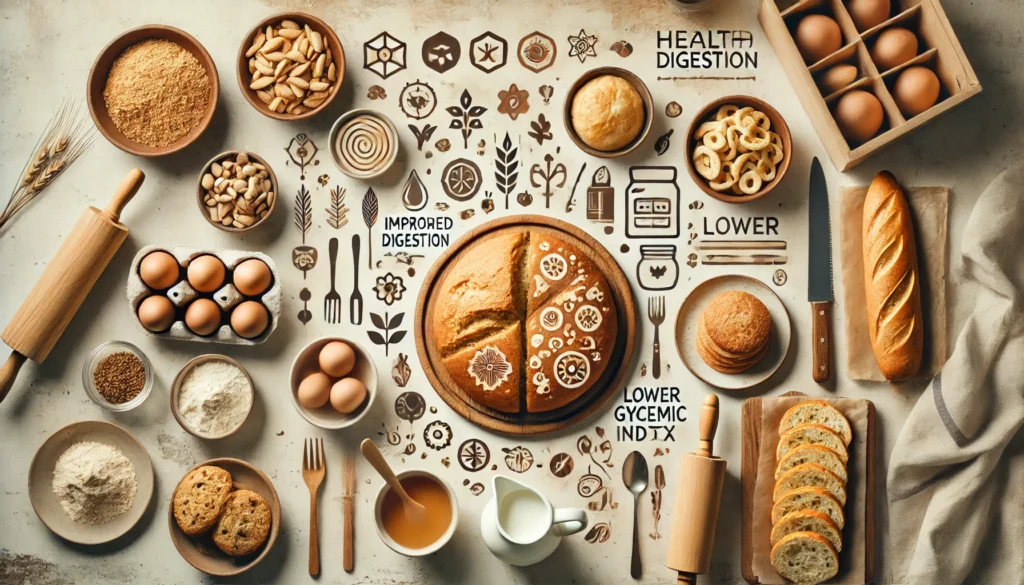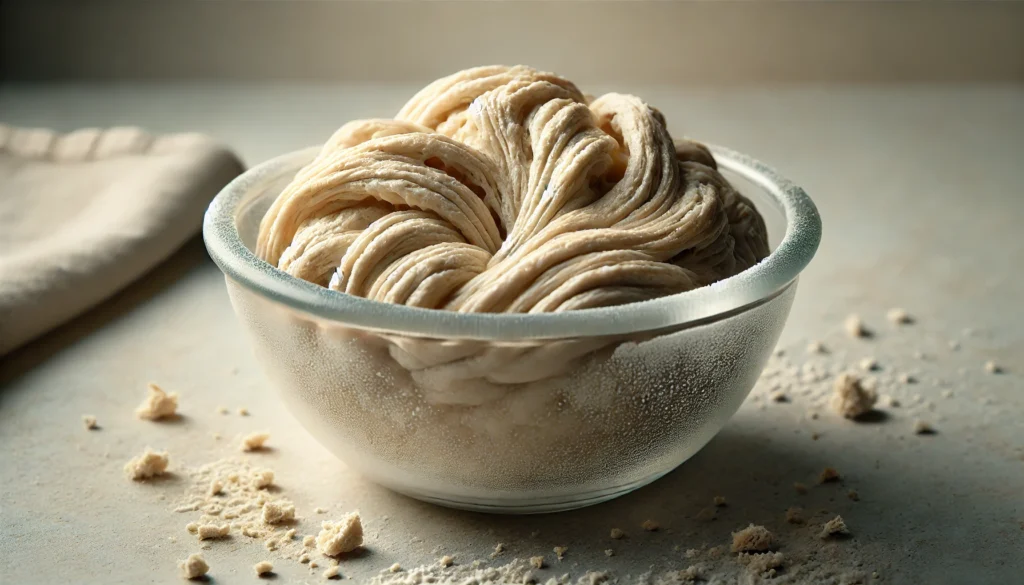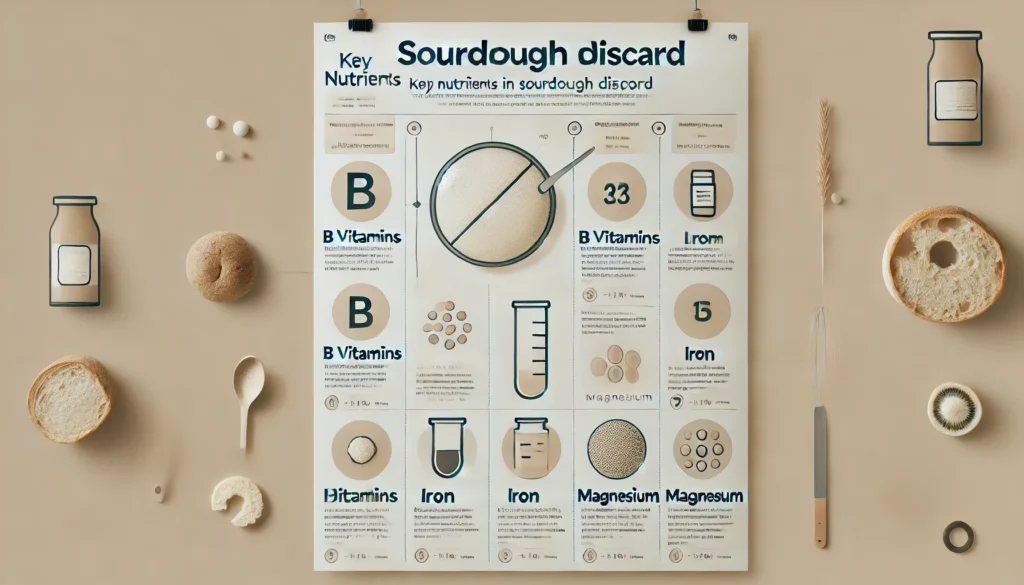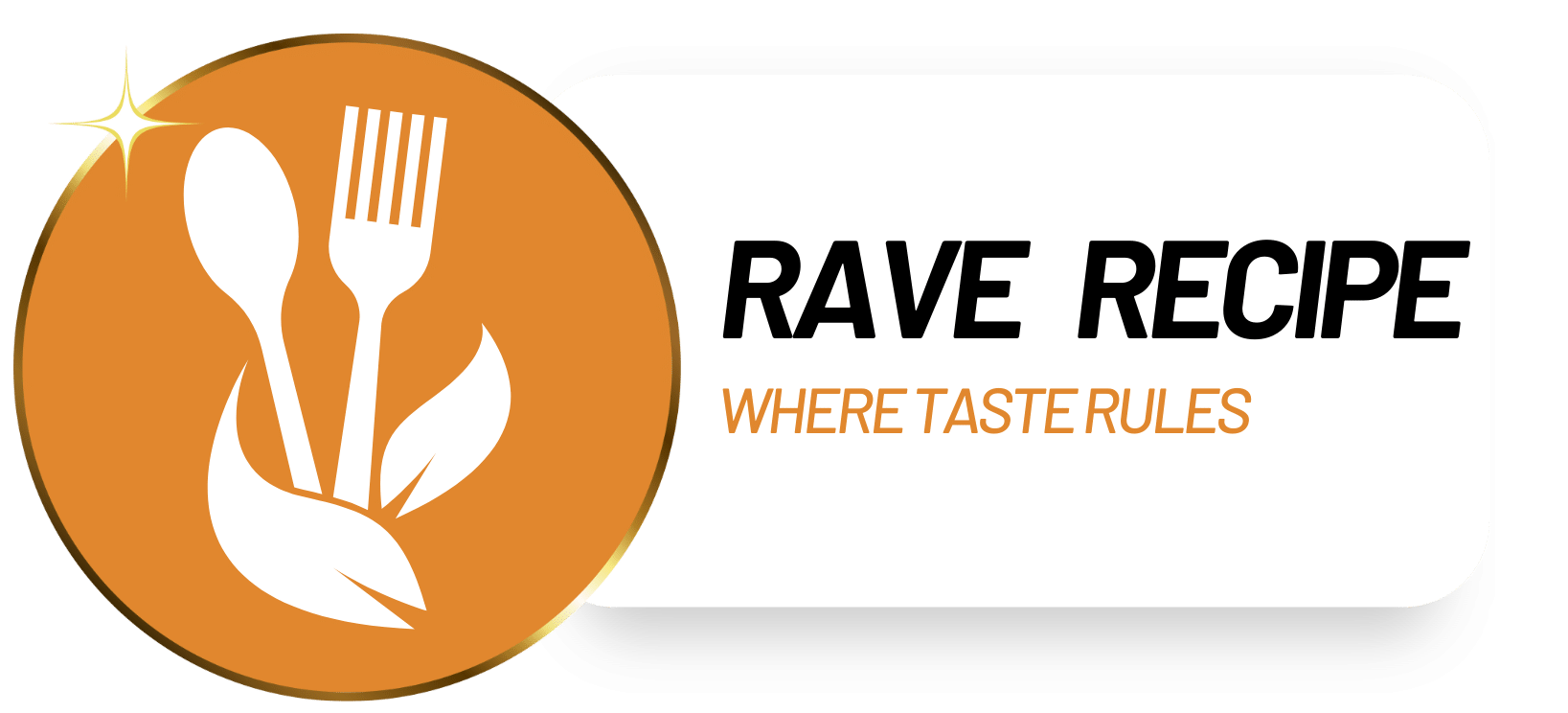
How Healthy is Sourdough Discard? A Comprehensive Guide
Sourdough baking has become incredibly popular in recent years, sparking curiosity about its byproducts. Many home bakers now wonder, How healthy is sourdough discard? This article explores the nutritional benefits, health considerations, and creative uses for sourdough discard. By the end, you’ll know whether this byproduct is a healthy addition to your diet or if it requires cautious use.
Part 1: Introduction

What is Sourdough Discard?
Bakers must remove a portion of their sourdough starter before feeding it fresh flour and water. This portion, known as discard, might seem like waste. However, it contains the same beneficial bacteria, natural yeasts, and nutrients found in the active starter. Despite being less fresh and bubbly, sourdough discard still has valuable qualities that influence how it performs in recipes.
The Growing Popularity of Sourdough Baking
Sourdough baking has captivated many, especially during global lockdowns. People enjoy creating and maintaining a sourdough starter and then baking flavorful loaves. As more people take up this practice, the question arises: What should we do with sourdough discard? Instead of tossing it out, many bakers find creative ways to use it in recipes. But, is this practice healthy? The next sections will explore the nutritional aspects and health implications of sourdough discard, along with practical ways to use it.
Let’s move on to discuss the nutritional value of sourdough discard and whether it’s a healthy option for you.
Nutritional Value of Sourdough Discard

Understanding how healthy is sourdough discard is crucial to determining if it’s a healthy choice. Sourdough discard, like its active starter, contains a variety of nutrients and beneficial components. However, the exact nutritional value can vary based on the storage duration and the type of flour used in the starter.
Key Nutrients in Sourdough Discard
Sourdough discard is a source of several essential nutrients, highlighting how healthy is sourdough discard. It’s rich in B vitamins, which are vital for energy production and cell health. The discard also provides minerals like iron, which supports oxygen transport, and magnesium, essential for muscle function and bone health.
Understanding how healthy is sourdough discard involves recognizing the role of fermentation in increasing nutrient availability. During this process, natural bacteria and yeast break down phytic acid—a compound that can block mineral absorption. This breakdown makes the minerals in sourdough discard more bioavailable, meaning your body can absorb them more efficiently.
Additionally, how healthy is sourdough discard becomes evident when considering its beneficial bacteria and enzymes. These probiotics support gut health by promoting a balanced microbiome, crucial for digestion and overall wellness. The discard also has a lower glycemic index than regular bread, causing a slower rise in blood sugar levels, which can help manage blood sugar.
Given how healthy is sourdough discard, it offers several health benefits when included in a balanced diet. Its probiotics may improve gut health, aiding digestion and boosting immunity. The lower glycemic index of sourdough products can be beneficial for those who need to manage their blood sugar levels, such as people with diabetes.
Sourdough discard also supports better mineral absorption due to the reduction of phytic acid during fermentation. Consuming foods made with sourdough discard may help you absorb more minerals from other foods you eat.
The fermentation process also makes sourdough products easier to digest. The bacteria and yeast partially break down gluten, which can be helpful for those with mild gluten sensitivities, though not safe for those with celiac disease.
Sourdough discard isn’t just a healthy option because of its nutrients; it also supports sustainability by reducing food waste. Instead of discarding it, using it in recipes contributes to a more eco-friendly lifestyle, which is an added benefit for those conscious of their environmental impact.
In summary, sourdough discard is more than just a byproduct. It’s a nutritious ingredient that can enhance the healthfulness of various recipes while also being kinder to the planet.
Health Considerations When Using Sourdough Discard

While sourdough discard offers nutritional benefits, it’s essential to consider certain health factors before incorporating it into your diet. These considerations will help you make informed decisions about when and how to use sourdough discard effectively.
Fermentation and Digestibility
The fermentation process involved in creating sourdough discard enhances the digestibility of the food you prepare with it. Understanding how healthy is sourdough discard reveals that the natural bacteria and yeast present partially break down gluten, making it easier to digest compared to traditional wheat products. For individuals with mild gluten sensitivities, this can be a significant advantage. However, it’s important to note that sourdough discard still contains gluten and is not suitable for those with celiac disease.
Additionally, the fermentation process increases the availability of certain nutrients by breaking down phytic acid, which can otherwise inhibit mineral absorption. This means that when you use sourdough discard, your body may absorb more minerals from the foods you eat alongside it.
Gluten Content and Sensitivities
For those who are sensitive to gluten, the question often arises: How healthy is sourdough discard for someone with gluten sensitivity? The answer depends on the level of sensitivity. Sourdough discard, like the starter itself, contains gluten, but the fermentation process reduces its concentration. This reduction might make sourdough discard tolerable for some with mild gluten sensitivity. However, it is not gluten-free, and those with celiac disease or severe gluten intolerance should avoid it altogether.
When considering whether to use sourdough discard in your recipes, assess your tolerance level carefully. If you notice any discomfort after consuming it, consider avoiding it or consulting a healthcare professional for advice.
Potential Downsides of Sourdough Discard
Despite its benefits, there are potential downsides to using sourdough discard. One concern is its acidity, which can be harsh on the stomach for some individuals, particularly when consumed in large quantities. If you have a sensitive stomach or are prone to acid reflux, you may want to limit your intake of sourdough discard-based foods.
Moreover, the nutritional benefits of sourdough discard can diminish if it’s stored for too long. Over time, discard can lose its beneficial properties, becoming less nutritious and potentially harboring harmful bacteria if not stored properly. To avoid these issues, always store your sourdough discard in a cool, dry place and use it within a reasonable time frame.
In summary, while sourdough discard offers numerous health benefits, it’s important to be aware of its potential downsides. Consider your own dietary needs and preferences when deciding how to incorporate sourdough discard into your meals.
Common Uses of Sourdough Discard
Sourdough discard is not just a byproduct to be tossed away; it’s a versatile ingredient that can add flavor and nutrition to a variety of recipes. From savory dishes to sweet treats, sourdough discard can be used in many creative ways, making it a valuable component in your kitchen.

Baking Recipes
One of the most popular uses for sourdough discard is in baking. Its unique tangy flavor and rich texture make it an excellent addition to many baked goods. Here are some popular options:
- Pancakes and Waffles: Sourdough discard adds a delicious tang to pancakes and waffles, enhancing their flavor profile. The discard also contributes to a fluffier texture due to the natural yeast it contains.
- Muffins and Quick Breads: Incorporating sourdough discard into muffins and quick breads can boost their nutritional value while also adding a slight sourdough flavor. Popular choices include banana bread, zucchini bread, and apple muffins.
- Crackers and Biscuits: The tanginess of sourdough discard is perfect for savory baked goods like crackers and biscuits. These can be enjoyed on their own or paired with dips and cheeses for a delightful snack.
These recipes not only reduce food waste but also offer a healthier alternative to traditional versions by incorporating the benefits of fermentation.
Sourdough Discard in Non-Baking Recipes
Beyond baking, sourdough discard can be used in a variety of non-baking recipes as well. Its versatility makes it an excellent ingredient for:
- Batter for Frying: Sourdough discard can be used to create a light, crispy batter for frying vegetables, seafood, or even chicken. The natural yeast in the discard helps the batter rise slightly, creating a delicate, airy texture.
- Thickening Sauces and Soups: The discard’s consistency makes it a great thickening agent for sauces and soups. It adds a slight tang while also giving body to the dish.
- Pizza Dough: Using sourdough discard in pizza dough can add depth to the flavor and create a chewier texture. The fermentation process also enhances the overall digestibility of the dough.
These non-baking uses for sourdough discard showcase its ability to enhance a wide range of dishes, making it a staple ingredient for those who love to experiment in the kitchen.
Tips for Using Sourdough Discard Safely
While sourdough discard is a versatile ingredient, it’s important to use it safely. Here are some tips to ensure you’re getting the most out of your discard:
- Use Fresh Discard: For the best flavor and nutritional benefits, use sourdough discard that is fresh. If stored for too long, the discard can develop off-flavors or become contaminated with harmful bacteria.
- Proper Storage: Store your sourdough discard in an airtight container in the refrigerator to slow down fermentation and prevent spoilage. Discard can be stored for up to a week, but it’s best used within a few days.
- Don’t Overuse: While sourdough discard is nutritious, it’s also acidic. Overusing it in recipes can result in overly tangy flavors or upset stomachs, particularly for those sensitive to acidity.
In summary, sourdough discard is an incredibly versatile ingredient that can be used in both baking and non-baking recipes. With proper handling, it can add flavor and nutrition to a wide range of dishes, making it a valuable resource in your kitchen.
FAQs about Sourdough Discard
As more people discover the joys of sourdough baking, questions about sourdough discard naturally arise. This section addresses some of the most frequently asked questions to help you understand how to use and store sourdough discard effectively.
Is Sourdough Discard Safe to Eat?
Sourdough discard is safe to eat as long as you store it properly and check for signs of spoilage, such as mold or a sour smell. It contains the same beneficial bacteria and yeasts as active sourdough starter, though it may be less potent in leavening. Always inspect your discard before using it, especially if it has been stored for several days.
Can I Freeze Sourdough Discard?
Yes, you can freeze sourdough discard to preserve it if you’re not planning to use it right away. To freeze, place the discard in an airtight container or a freezer-safe bag, and label it with the date. It can remain frozen for up to three months. When ready to use, thaw the discard in the refrigerator overnight and stir it well before incorporating it into your recipes.
How Long Does Sourdough Discard Last?
Sourdough discard typically lasts up to a week in the refrigerator if stored in an airtight container. However, using it sooner will provide better flavor and more active bacteria and yeast. Over time, discard develops a more intense sour flavor, which might be desirable for some recipes but overpowering for others.
Is Sourdough Discard Good for Gut Health?
Sourdough discard can benefit gut health because it contains probiotics—beneficial bacteria that support a healthy digestive system. These probiotics result from the fermentation process, which also breaks down gluten and other components in flour, making the discard easier to digest. However, cooking at high temperatures can reduce the probiotic content, so using discard in raw or lightly cooked dishes may offer the most benefits.
Can You Eat Sourdough Discard Raw?
While it is technically safe to eat sourdough discard raw, it is not commonly consumed this way due to its strong, tangy flavor and the presence of raw flour. However, some people use it in uncooked preparations like certain batters or fermented foods. If you choose to consume it raw, ensure that your discard is fresh and free from spoilage.
Conclusion
Sourdough discard, often overlooked as a byproduct, is a versatile and nutritious ingredient. It offers several health benefits, from its rich nutrient profile to its contribution to gut health through probiotics. When used properly, it can be a valuable addition to your diet.
Understanding its nutritional value helps you make informed decisions about incorporating sourdough discard into your meals. Whether you’re baking, thickening soups, or experimenting with creative recipes, this ingredient adds both flavor and health benefits.
Consider your dietary needs, especially if you have gluten sensitivities or a sensitive stomach. By using fresh discard and storing it safely, you can enjoy its benefits while minimizing any potential downsides.
Incorporating sourdough discard into your cooking reduces waste and promotes mindful eating. The next time you prepare a sourdough starter, remember that the discard can be just as valuable as the bread it helps create.

